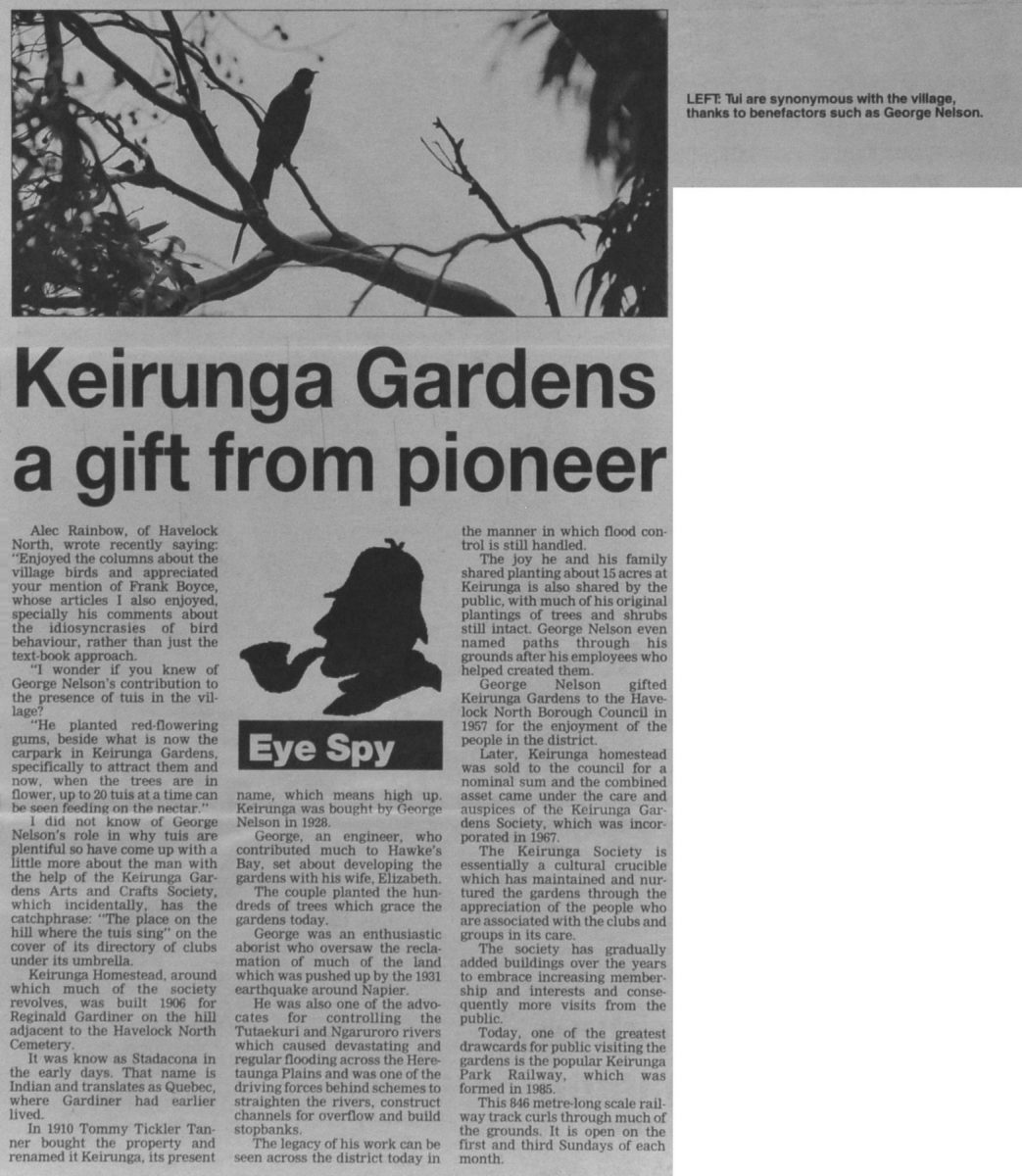Keirunga Gardens a gift from pioneer
Eye Spy
Alec Rainbow, of Havelock North, wrote recently saying: “Enjoyed the columns about the village birds and appreciated your mention of Boyce, whose articles I also enjoyed, specially his comments about the idiosyncrasies of bird behaviour, rather than just the text-book approach.
“I wonder if you knew of George Nelson’s contribution to the presence of tuis in the village?
“He planted red-flowering gums, beside what is now the carpark in Keirunga Gardens, specifically to attract them and now, when the trees are in flower, up to 20 tuis at a time can be seen feeding on the nectar.”
I did not know of George Nelson’s role in why tuis are plentiful so have come up with a little more about the man with the help of the Keirunga Gardens Arts and Crafts Society, which incidentally, has the catchphrase: “The place on the hill where the tuis sing” on the cover of its directory of clubs under its umbrella.
Keirunga Homestead, around which much of the society revolves, was built 1906 for Reginald Gardiner on the hill adjacent to the Havelock North Cemetery.
It was known as Stadacona in the early days. That name is Indian and translates as Quebec, where Gardiner had earlier lived.
In 1910 Tommy Tickler Tanner bought the property and renamed it Keirunga, its present name, which means high up. Keirunga was bought by George Nelson in 1928.
George, an engineer, who contributed much to Hawke’s Bay, set about developing the gardens with his wife, Elizabeth.
The couple planted the hundreds of trees which grace the gardens today.
George was an enthusiastic aborist [arborist] who oversaw the reclamation of much of the land which was pushed up by the 1931 earthquake around Napier.
He was also one of the advocates for controlling the Tutaekuri and Ngaruroro rivers which caused devastating and regular flooding across the Heretaunga Plains and was one of the driving forces behind schemes to straighten the rivers, construct channels for overflow and build stopbanks.
The legacy of his work can be seen across the district today in the manner in which flood control is still handled.
The joy he and his family shared planting about 15 acres at Keirunga is also shared by the public, with much of his original plantings of trees and shrubs still intact. George Nelson even named paths through his grounds after his employees who helped created them.
George Nelson gifted Keirunga Gardens to the Havelock North Borough Council in 1957 for the enjoyment of the people in the district.
Later, Keirunga homestead was sold to the council for a nominal sum and the combined asset came under the care and auspices of the Keirunga Gardens Society, which was incorporated in 1967.
The Keirunga Society is essentially a cultural crucible which has maintained and nurtured the gardens through the appreciation of the people who are associated with the clubs and groups in its care.
The society has gradually added buildings over the years to embrace increasing membership and interests and consequently more visits from the public.
Today, one of the greatest drawcards for public visiting the gardens is the popular Keirunga Park Railway, which was formed in 1985.
This 846 metre-long scale railway track curls through much of the grounds. It is open on the first and third Sundays of each month.
Photo caption – LEFT: Tui are synonymous with the village, thanks to benefactors such as George Nelson.












Do you know something about this record?
Please note we cannot verify the accuracy of any information posted by the community.